
Fishing for red drum and speckled trout during early spring is elementary, if anglers are careful in their approach.
From his perch on the poling platform, Capt. Tommy Rickman pointed to the back of a shallow cove.
“Do you see those fish pushing water?” he said in a hoarse, half whisper. “They’re almost all the way to the marsh and a little to the left of that great blue heron. There’s one again right now.”
Nodding in recognition, I focused attention on several fish wakes in the calm water as Rickman (Southport Angler Outfitters, 866-395-FISH, www.fishsouthport.com) slipped a push pole into the water and gave his FlyCraft flats skiff an easy shove forward.
“This water is really skinny, and these fish were extremely spooky the other day, so I don’t want to risk using the trolling motor to get there a little quicker,” Rickman said in a quiet voice. “It’ll take us a few more minutes to get over there in casting range, but we should get there without disturbing them.
“Go ahead and get ready to cast, but don’t risk a short one. Be sure you can reach the edge of the marsh grass when you let go.”
Meanwhile, the drum continued to feed on minnows and shrimp the falling tide was forcing out of the grass. If the school of reds realized Rickman’s boat was near, they didn’t show any alarm but were focused on getting an easy meal during the falling tide as we crept within ambush range.
Rickman paused his poling and told me to try a cast toward the bank with a small spinning reel.
A short back cast loaded the rod and with a quick forward rotation of forearm and flip of wrist the lure was sailing through the air. The lure lightly splashed into the mirror-calm water inches from the perimeter of the standing marsh grass and a few feet in front of the most recent red drum wake.
As I flipped the bail closed, the wake exploded on the surface as a drum lunged for the lure. I managed to get the line tight in time to feel a jolt as the drum struck and turned to outrun several of his schoolmates who also wanted a taste.
I jerked hard on the rod a couple of times to be sure to drive the hook into the drum’s jaw. Suddenly line began to fly off the squealing reel as the redfish surged away in reaction to the unexpected stinging sensation in its chops.
Unexpectedly, as the frantic drum raced across the back of the shallow bay, it erupted into a commotion. A huge redfish school had been resting, but the wild dash of the hooked fish spooked them in every direction. Their wakes were enough to rock Rickman’s boat for a minute or more.
If we hadn’t been engaged in trying to land a nice fish, no doubt we would have been shocked into stunned silence. Few people witness a coastal bay literally explode with upper-slot puppy drum.
After a few minutes, the tiring mid-slot drum allowed itself to be led into Rickman’s net. If we’d wanted a redfish for dinner, this one would have been a nice keeper.
As Rickman revived the drum before releasing it, he noted a catch with the first cast was a great way to start a fishing trip. We didn’t know the day was destined to become even better.
Unfortunately, when the large school of drum exploded, the fish became spooked by the intensity of their own movements. From his poling platform, Rickman saw smaller groups of fish milling about in the small bay, but they were nervous. Although we got within casting range several times, the redfish jumped each time a lure splashed into the water.
Rickman suggested we leave and return later if we didn’t find fish at a couple of other spots. A break also would give the big school of reds time to calm and begin feeding.
As we entered his second area, a smaller bay with a deeper channel, Rickman maneuvered his boat around a small island but paused to check the water.
“I spooked (red drum) bad in here the other day, so I’m going to be real careful,” Rickman said. “(The redfish) usually are back in that corner to the right, but they were right up there, just off that little point … I ran over them with the trolling motor and scattered them.
“This bottom is a little cleaner so why don’t you switch from a jerkbait to a spinnerbait? Cast up there, a few feet off the bank and see if anybody is home.”
The cast dropped into the water without scaring any fish. During the retrieve, Rickman noted that even though the water was warming, it was still a little cool and the retrieve shouldn’t be too fast. As I cranked fast enough to feel the gold Colorado blade begin to pulsate, something grabbed the lure, sending a thump up the line.
When an angler feels a shot like that transmitted along his line, instincts take over. Sometimes a hard stop of a lure is an oyster rock or a stump and the angler feels foolish for setting his hook — but this was the real thing.
The little reel squealed in agony as line escaped through the guides of the deeply bent rod, and a stud redfish burst for cover deeper in the cove.
“I guess the warming water has these fish moving farther out of this spot than they did during the cold of winter,” Rickman said. “I’m sure glad we stopped out here rather than pushing on in.”
As another slot redfish tired and came to the boat, Rickman noted its fight had disturbed only a few fish, so we should be able to catch some more, which proved to be a good prediction. We caught some nice reds inside the little bay, including one lunker about 31 inches in length. That drum put up quite a battle, making several strong runs in the warming water.
We admired the redfish a few minutes and talked about how its red coloring would change and how the trailing edge of its tail was a distinct blue. While not a lot of anglers know it, the red drum is the state fish. The red drum Fisheries Management Plan has brought these fish back from near depletion to a point where anglers now have reasonable expectations of catching them the entire year. We also talked about how, if left alone, red drum fishing could get even better in North Carolina.
After reviving the big red and watching it swim away, Rickman suggested trying the oyster rocks and shell islands in the Elizabeth River for speckled trout. It had been a great morning; we’d seen hundreds of drum, so we left in search of some specks.
Keeping to their elusive nature, we didn’t locate spotted seatrout as easily as we found redfish. However, with Rickman’s local knowledge of the area and a little exploration, we found them.
The first place that held specks that morning was unusual — Rickman previously hadn’t discovered the place.
We were casting 4-inch paddle tail Blurp grubs in new penny and root beer colors to a drop-off beside an oyster rock. After a while we worked around the upriver end and found a fairly large corner that was blocked off during low tide. Several drum were working down the edge of the oyster rocks in water so shallow we could see their tails.
When an opportunity like that presents itself, most anglers take advantage, so we lobbed casts to opposite ends of the pod of drum. As we worked the grubs back to deeper water, we got strikes that didn’t feel or run like drum.
One hookup was a speckled trout of about 15 inches in length. Repeating the scenario, another speck came from just beside the still-visible drum. This scenario continued for several casts until the pod of drum left the area.
“I don’t believe I’ve ever seen anything quite like that,” Rickman said while we waited (unsuccessfully) for the drum to regroup and reappear one more time. “There’s no doubt those are drum we were casting to. I can see the blue edge on their tails. I don’t know why we aren’t catching them and are catching trout, but I won’t complain.”
Later we decided the drum must have been grubbing along the sides of the oyster rocks and the trout were following them in slightly deeper water, eating morsels the drum had uncovered but that escaped the reds. The side of that oyster rock featured a deep drop, scaling from several inches to several feet deep in about a yard.
Rickman motored to several other locations in the lower Cape Fear River and Elizabeth River that morning that surrendered a few fish. But none of the spots were quite as exciting as the one where we found the day’s first reds or the unexpected trout shadowing the pod of drum.
Even better, we’d fooled all the fish with artificial baits and hadn’t resorted to using the mud minnows Rickman had collected “just in case.”
Rickman said there were some good opportunities for spring trout and reds in the Southport area and he was correct. The drum were nice sizes and, while still waking up a little from the cold of winter, they fed heavily and readily challenged a variety of lures.
The speckled trout were small but well above the legal minimum size. As is their nature, the specks were a little more reclusive and difficult to find but proved to be hungry once we found them.
Overall, we experienced a great morning of fishing and could have boated several meals of fish had we been inclined. In the words of the old first-grade reading skills book, Tom and Jerry got to see spots and specks run.


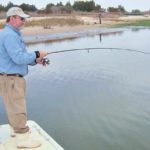
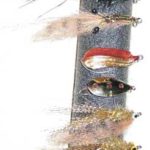
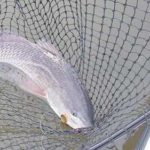
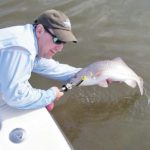
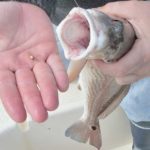




Be the first to comment